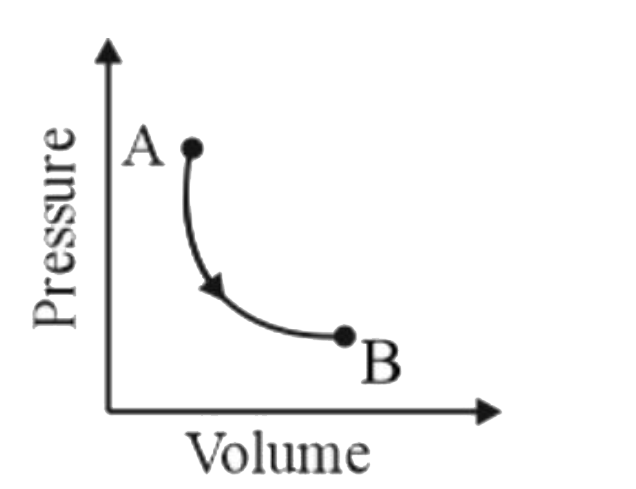On an isothermal process, there are two POINTs A and B at which pressures and volumes are (2P0,V0) and (P0,2V0) respectively. If A and B are connected by a straight line, find the pressure at a POINT on this straight line at which temperature is maximum
4P03
54P0
32P0
75P0
The correct Answer is:C
To solve the problem step by step, we will follow the process outlined in the video transcript.
Step 1: Understand the Points A and B
We have two points A and B on an isothermal process:
- Point A: Pressure PA=2P0, Volume VA=V0
- Point B: Pressure PB=P0, Volume VB=2V0
Step 2: Equation of the Straight Line AB
The equation of the straight line connecting points A and B can be derived using the two-point form of the line equation. The general form is:
y−yAx−xA=yB−yAxB−xA
Here, we replace y with pressure P and x with volume V:
P−2P0V−V0=P0−2P02V0−V0
This simplifies to:
P−2P0V−V0=−P0V0
Step 3: Rearranging the Equation
Cross-multiplying gives:
P−2P0=−P0V0(V−V0)
Rearranging this leads to:
P=2P0−P0V0(V−V0)
Step 4: Expressing PV
Multiplying both sides by V:
PV=V(2P0)−P0V0(V2−VV0)
This can be expressed as:
PV=2P0V−P0V0V2+P0V0VV0
Step 5: Relating to Temperature
Using the ideal gas law PV=nRT, we can equate:
nRT=2P0V−P0V0V2+P0V
Rearranging gives:
nRT=2P0V−P0V0V2+P0V
Step 6: Finding Maximum Temperature
To find the maximum temperature, we differentiate T with respect to V and set the derivative to zero:
dTdV=0
This leads to:
2P0−P0V0(2V−V0)=0
Step 7: Solving for V
Solving the equation:
2P0=P0V0(2V−V0)
Cancelling P0 and rearranging gives:
2=2VV0−1
Thus,
3=2VV0
This implies:
V=32V0
Step 8: Finding Pressure at Maximum Temperature
Substituting V=32V0 back into the equation for pressure:
P=2P0−P0V0(32V0−V0)
This simplifies to:
P=2P0−P0V0(12V0)=2P0−12P0=32P0
Final Answer
The pressure at the point on the straight line where the temperature is maximum is:
32P0
We have two points A and B on an isothermal process:
- Point A: Pressure PA=2P0, Volume VA=V0
- Point B: Pressure PB=P0, Volume VB=2V0
The equation of the straight line connecting points A and B can be derived using the two-point form of the line equation. The general form is:
y−yAx−xA=yB−yAxB−xA
Here, we replace y with pressure P and x with volume V:
P−2P0V−V0=P0−2P02V0−V0
This simplifies to:
P−2P0V−V0=−P0V0
Cross-multiplying gives:
P−2P0=−P0V0(V−V0)
Rearranging this leads to:
P=2P0−P0V0(V−V0)
Multiplying both sides by V:
PV=V(2P0)−P0V0(V2−VV0)
This can be expressed as:
PV=2P0V−P0V0V2+P0V0VV0
Using the ideal gas law PV=nRT, we can equate:
nRT=2P0V−P0V0V2+P0V
Rearranging gives:
nRT=2P0V−P0V0V2+P0V
To find the maximum temperature, we differentiate T with respect to V and set the derivative to zero:
dTdV=0
This leads to:
2P0−P0V0(2V−V0)=0
Solving the equation:
2P0=P0V0(2V−V0)
Cancelling P0 and rearranging gives:
2=2VV0−1
Thus,
3=2VV0
This implies:
V=32V0
Substituting V=32V0 back into the equation for pressure:
P=2P0−P0V0(32V0−V0)
This simplifies to:
P=2P0−P0V0(12V0)=2P0−12P0=32P0
The pressure at the point on the straight line where the temperature is maximum is:
32P0
Topper's Solved these Questions
- KINETIC THEORY OF GASES AND FIRST LAW OF THERMODYNAMICSBOOK - CENGAGE PHYSICS ENGLISHCHAPTER - KINETIC THEORY OF GASES AND FIRST LAW OF THERMODYNAMICSEXERCISE - Multiple Corrects
29 Videos
- KINETIC THEORY OF GASES AND FIRST LAW OF THERMODYNAMICSBOOK - CENGAGE PHYSICS ENGLISHCHAPTER - KINETIC THEORY OF GASES AND FIRST LAW OF THERMODYNAMICSEXERCISE - Assertion-Reasoning
6 Videos
- KINETIC THEORY OF GASES AND FIRST LAW OF THERMODYNAMICSBOOK - CENGAGE PHYSICS ENGLISHCHAPTER - KINETIC THEORY OF GASES AND FIRST LAW OF THERMODYNAMICSEXERCISE - Subjective
22 Videos
- KINETIC THEORY OF GASESBOOK - CENGAGE PHYSICS ENGLISHCHAPTER - KINETIC THEORY OF GASESEXERCISE - Compression
2 Videos
- LINEAR AND ANGULAR SIMPLE HARMONIC MOTIONBOOK - CENGAGE PHYSICS ENGLISHCHAPTER - LINEAR AND ANGULAR SIMPLE HARMONIC MOTIONEXERCISE - Single correct anwer type
14 Videos
Similar Questions
On an isothermal process ,there are two points A and B at which pressures and volumes are (2P0,V0) and (P0,2V0) respectively. A and B are connected by a straight line then , the temperature of the isothemal process is how much lower the maximum temperature :
View SolutionPressure and volume of a gas changes from (p0V0) to (p04,2V0) in a process pV2= constant. Find work done by the gas in the given process.
View SolutionLet 2a+2b+c=0 , then the equation of the straight line ax + by + c = 0 which is farthest the point (1,1) is
View SolutionInitial pressure and volume of a gas are P and V respectively. First its volume is expanded to 4V by isothermal process and then again its volume makes to be V by adiabatic process then its final pressure is (γ=1.5) -
View SolutionThe straight line passing through the point of intersection of the straight line x+2y−10=0and2x+y+5=0 is
View SolutionThe coordinates of the point A and B are (a,0) and (−a,0), respectively. If a point P moves so that PA2−PB2=2k2, when k is constant, then find the equation to the locus of the point P.
View SolutionThe coordinates of the point AandB are (a,0) and (−a,0), respectively. If a point P moves so that PA2−PB2=2k2, when k is constant, then find the equation to the locus of the point P.
View SolutionFind the equation of two straight lines which are parallel to the straight line x+7y+2=0, and at a unit distance from the point (2, -1).
View SolutionThe pressure and volume of an ideal gas are related as pα1v2 for process A→B as shown in figure . The pressure and volume at A are 3p0andv0 respectively and pressure B is p0 the work done in the process A→B is found to be [x−√3]p0v0 find

View SolutionTwo points (a,0) and (0,b) are joined by a straight line. Another point on this line , is (A)(3a,−2b) (B) (a2,ab) (C) (−3a,2b) (D) (a,b)
View Solution
